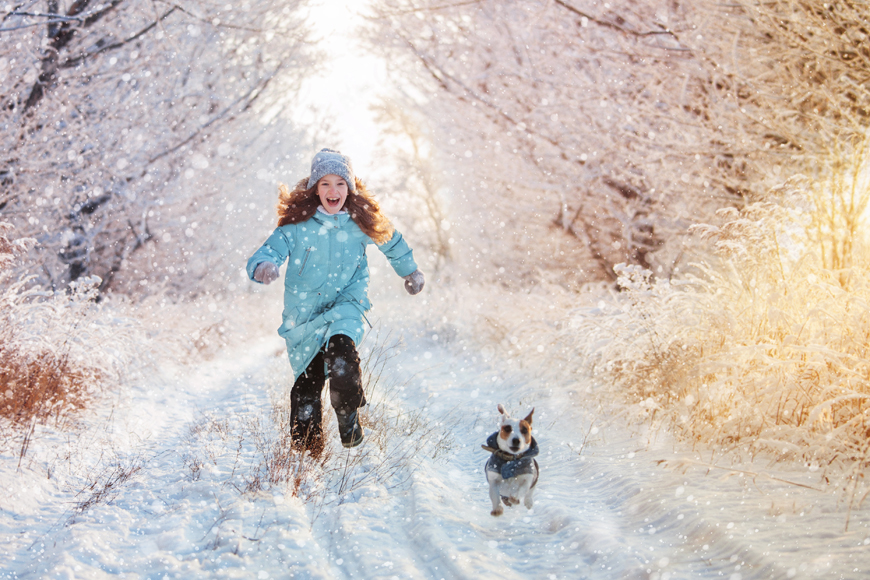
Top tips to stay healthy when out with your dog this winter
We all love dog walks in winter in our #warmwellies, but it's important to remember a few considerations we can often take for granted.
TRUE GRIT – AVOID IT!
Beware the road gritters. Not because the passing gritter vehicles can smack your legs with grit and salt as you walk past, but most importantly, to protect your dog. Gritters spread grit and salt and de-icing chemicals – and these can be harmful and burn paws with prolonged contact. The salt is not good for dogs to lick either.

AVOID ANTIFREEZE
Antifreeze is poisonous but very, very tasty to dogs. Keep it well away from your animals and mop up spills.
GREAT BALLS OF ICE
We may be wearing neoprene lined Warm Wellies, but dogs just have paw pads, which, for some hairy breeds can be a nuisance in snow. Check their feet are not developing balls of ice between their pads – it will make walking uncomfortable and a tad painful.
SNOW TIME TO LET GO
On pet related websites you will see lots of advice to keep your dog on a lead. That’s because there may be deep patches or holes that are unsafe – and unseen. Snow covers areas that aren’t safe – for you or the dog, and you won’t spot them when there is thick snow lying. If you know the area well it is very tempting to let them have a rummage in the snow, rolling and having fun, or catching snowballs, but do be aware of your surroundings. If your dog is snowy white – you do need to keep an eye to see where they are!
BE SEEN AND BE SAFE
It is so important to be visible at all times, but never more so than in bad weather - or in snowy conditions. A collar is a MUST, along with an ID tag, and of course it should be microchipped too. Is your microchip database up to date? On average, people move home every 5-10 years. Make sure your equipment is checked too – easy clips, no fraying leads, or harnesses. They all need to be functional. Fluorescent jackets or leads will make sure others see you too – and that’s not just for snowy conditions. Mabel is black so she has a reflective jacket to make sure she is easily spotted on dark winter nights
WELLY AND DOG WIPEs AFTER WALKIES
It goes without saying, we wash our warm wellies when we come in from salty walks (I hope!), so remember to do the same for your dog. Leg, feet, and stomach as the grit we mentioned earlier can irritate their skin. Hints to take care of your Warm Wellies
NO COLD CAR
We all know not to leave our dogs in the car when it’s hot, but the same applies when it is cold.
ON FROZEN POND
We are heavier than our dogs and wouldn’t walk on frozen ponds, but that doesn’t mean we should let our dogs walk, run, skid, or slide on ice either. It may not be as thick with ice as you think. Just imagine your dog falling through, the anguish! And remember, you should not be tempted to go in after them, it is very dangerous. According to the Royal Society for the Prevention of Accidents (Rospa), on average there are seven animal rescue-related deaths in the UK a year. Animals are more resilient than we think. They can deal with cold and freezing water for longer than we can. The charity says, “in most of the cases when people have gone in to rescue a dog, it has got out safely a few minutes later”.
SNOW COLD – TOO COLD
We all know our own dogs, so we are likely to spot changes in behaviour if they are cold. It’s important to remember that smaller breeds and short-haired coats are more at risk of getting cold. In the UK frostbite is less likely – unless you are scaling snow mountains, and most dogs have enough fur layers to give extra insulation. However – paws are still exposed.
Short walks are better – and if the temperature dips to -6 (20F) or less, then a half-hour walk is enough. All the dog-friendly sites recommend supplementing short walks with fun indoor activities. Hide the ball, create obstacle courses, and teach new tricks!
How to tell if your dog is too cold We looked at a Canadian rescue site which gives a good list of indicators that your dog is too cold:
- Shaking or shivering
- Hunched posture with a tucked tail
- Whining or barking
- Change in behaviour, like seeming anxious or uncomfortable
- Reluctance to keep walking or tries to turn around
- Seeks places for shelter
- Lifts paw off the ground
It’s unlikely that your dog will be walking in temperatures as cold as in Ontario, but the Ontario SPCA say if your dog does get too cold, wrap it in a blanket. And if you are worried about frostbite or hypothermia (fingers crossed not!), then signs to look out for are:
Frostbite (can take several days to develop)
- Often presents on the extremities (ears, legs, paws, tail)
- Pale, cold skin that can be painful to touch
- May develop redness, swelling and blisters of exposed skin
- Skin may turn black
Hypothermia (can range from mild to severe)
- Prolonged shivering
- Weakness
- Muscle stiffness
- Difficulty walking
- Pale gums
- Confusion
- Slow, shallow breathing
- Loss of consciousness
Obviously, don’t wait for signs of discomfort, call it quits when you need to. You know your dog so you will be aware of change. If in doubt and you are concerned about your dog, always seek veterinary advice.
